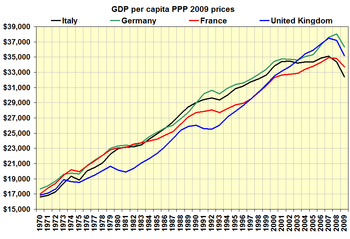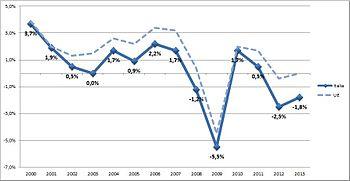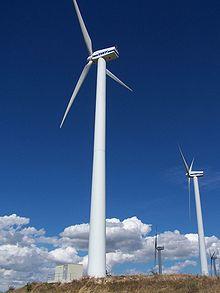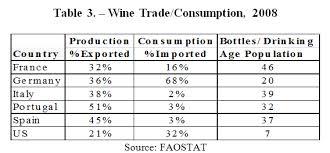Italy is the 8th largest economy in the world. It is also the 4th largest in Europe in terms of nominal GDP (refer to appendix 1). It has a diverse and industrialized financial system. In addition, the GDP per capita is high. Within a short period of time, Italy has changed from an economy dependent on agriculture to one of the world’s most industrialized nations. It is also one of the most prominent nations in the world market.
The country also enjoys high standards of living and is ranked 8th in the world with regard to this (McDonald, 2005). Most of Italy’s success is attributed to a stable political system and other pillars that support its GDP. GDP is one of the factors used to determine the status of an economy. Italy has had an almost perfectly stable GDP for a number of years (refer to appendix 2). In this paper, the author will analyze a number of issues related to the country’s economy.
The Main Pillars of Italy’s GDP
One of the factors contributing positively to the GDP of Italy is the availability of a large and highly paid labor force. High wages and increased output are necessary for economic growth (Holm, 2006). Increased salaries show that employers are making enough profits to pay their employees for their hard labor. The money enters the economy as individuals purchase products. The development increases demand and, ultimately, supply.
Italy’s labor force is estimated to be 24.49 million individuals. It is another factor that contributes to a strong GDP in Italy (Holm, 2006). Laws are put in place to protect the workforce and maintain productivity. The law provides the employees with the right to join and form unions. With regard to this, between 35 and 40 percent of Italian employees are unionized.
The law also sets the legal time for workers at 40 hours per week. Overtime is not supposed to exceed two hours per day. The high wages of Italian employees affect productivity positively as companies seek for other inexpensive ways to increase output (McDonald, 2005). The result is affordable goods produced in large quantities, leading to a strong and stable GDP.
The availability of economic resources is another pillar that has led to the high GDP in Italy. They include physical resources to produce goods and services efficiently. In Italy, raw materials, capital, and other items required for production are widely available (McDonald, 2005). For instance, many industries in the country source their raw materials from northern Italy. Some of these materials are exported in their raw state.
Another economic resource that is readily available is electricity. Italy imports most of the energy required to power its businesses and industries due to a lack of substantial deposits of natural resources (Holm, 2006). However, the country is still able to meet most of its power needs by producing renewable energy.
The economy achieves this by harnessing solar and wind energy (refer to appendix 3). The availability of these resources leads to an inexpensive price point. It allows for the maximization of the resources. In addition, it leads to competition as companies seek to obtain more resources than others. The development increases supply in the market, which enhances GDP growth (Holm, 2006).
High investor confidence has also increased the growth of Italy’s economy. In 2013, the country’s GDP stood at 136%. As a result, Italy had the second-largest public debt ratio in the Eurozone. However, in spite of the fact that this level of debt was sustainable, it made the economy highly vulnerable to swings in market confidence (Holm, 2006).
As a result, the Italian authorities made efforts to provide a structural surplus. The objective of such a move is to reduce public debt. The government also restores investor confidence in the country. High investor’s confidence indicates that people are willing to spend money on the economy (Holm, 2006). Similarly, increased business confidence raises output in order to meet the high demand for consumer products.
Freedom and the ability of the government to protect private property is another factor behind Italy’s economic growth. The two elements encourage individuals to enhance their livelihoods (McDonald, 2005). In light of this, Italy experiences GDP growth as an individual’s self-interests takes over (Holm, 2006). By protecting the rights of citizens and providing a free operating environment, Italy is able to guarantee the economic success of its populace.
Italy’s Major Exports and their Competitive and Comparative Advantage
A nation is said to have a comparative advantage if it can produce a particular product at a low relative opportunity cost prior to trade (Federici & Marconi, 2002). Most countries in the EU trade in a wide range of products.
However, most of these goods and services are commonly produced by all the countries, leading to increased competition in the export market. However, Italy has been able to overcome these challenges by gaining an edge over most of its competitors. The country has unique exports compared to other countries (refer to appendix 4). Some of these products are analyzed below:
Wine
Italy’s geographic location and climate have made the country famous throughout the world with regard to wine production. The nation is referred to as the ‘land of wine.’ Italy faces stiff competition from France, Chile, Argentina, Spain, and Australian wine industries (Federici & Marconi, 2002). The country overcomes this rivalry by branding its products (refer to appendix 5). Italian wine is widely sought after in most countries for its high quality.
The major markets for Italian wine include the USA, Taiwan, and the Middle East (Federici & Marconi, 2002). The ability to brand and promote wine based on quality alone is an added advantage that most countries in the EU cannot compete with. Other factors that place Italy at a competitive advantage include an existing domestic market. The market attracts foreign investment and enhances adaptability to changes in the industry.
Fashion and Design
Italy is known for its high-quality fashion products (Federici & Marconi, 2002). The ‘made in Italy stamp’ in the fashion and design industry is associated with high quality and style. Many importers opt to pay a lot of money for Italian textiles.
However, it is important to note that the competitive advantage that Italy has over other countries in the textile industry comes under constant attack from various external factors. For instance, the expiration of the World Trade Organization’s longstanding system of textile quotas in 2005 opened up Italy to a world of unfettered competition, which lowered the country’s textile exports (Federici & Marconi, 2002).
Other areas where Italy’s exports indicate comparative advantage include the hides and skins, footwear, metals, and chemical industries. In earlier studies, it was assumed that the attractive and high-quality design of Italian machines and cars gave the country an advantage over other nations.
However, recent surveys have shown this to be false. Research has actually shown that Italy is a less efficient producer compared to other countries in the world with regards to the transportation of products. As a result, the economy has a comparative disadvantage in this area (Federici & Marconi, 2002).
The Importance of Italy’s Domestic and Foreign Trade
In today’s globalized economy, it is important for a country to sell its products in both the domestic and foreign markets. Domestic trade, also known as internal or home trade, is the exchange of locally produced goods and services within the borders of a country (Holm, 2006).
Commerce is very important to the economy of a country. As a result, domestic trade in Italy is widely encouraged by the government for a number of reasons. One of the factors is that it facilities the exchange of products within the country (Holm, 2006). By doing this, the government ensures that factors of production reach the right places so that the economy can grow. Quality of life improves when products reach to all parts of the country (McDonald, 2005).
Foreign trade is also important to the Italian economy. It ensures that traders from outside the country come into contact with local producers. As a result, the transfer of technology is increased. As a result, Italy benefits from its interactions with other economies around the world (Federici & Marconi, 2002).
Conclusion
Italy is one of the largest economies in the world. The various aspects of domestic and foreign trade have impacted positively on the economy of this country. It is clear that for a country to survive in today’s competitive world, it has to engage in both domestic and international trade. In addition, it is apparent that comparative advantage gives a country an edge over its competitors in the international market. The Italian government has realized that it is important to adapt to changes in the domestic and foreign markets.
References
Federici, D., & Marconi, D. (2002). On exports and economic growth: The case of Italy. The Journal of International Trade & Economic Development, 11(3), 323-340.
Holm, K. (2006). Europeanizing export controls: The impact of the European Union code of conduct on exports in Belgium, Germany, and Italy. European Security, 15(2), 213-234.
McDonald, J. (2005). Domestic regulation, international standards, and technical barriers to trade. World Trade Review, 4(2), 249.
Appendix
Appendix 1: The GDP per Capita for Selected European Countries

Appendix 2: A Comparison of Italy’s GDP Growth with that of the EU

Appendix 3: Italy’s Renewable Energy

Appendix 4: Italy’s Major Exports

Appendix 5: Wine Trade among European Nations in 2008
